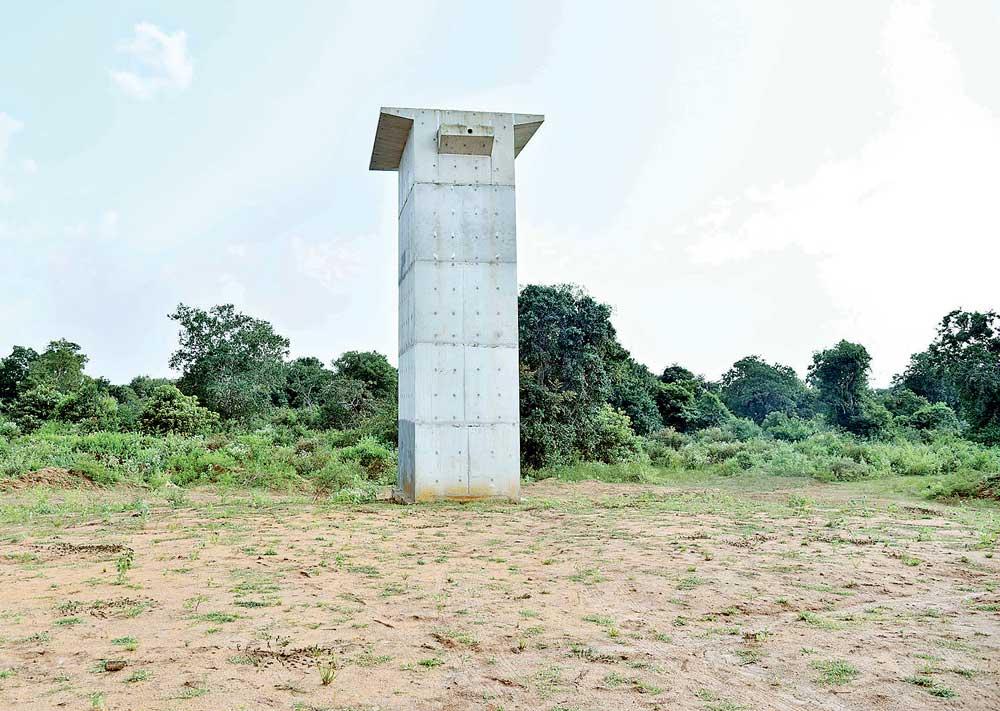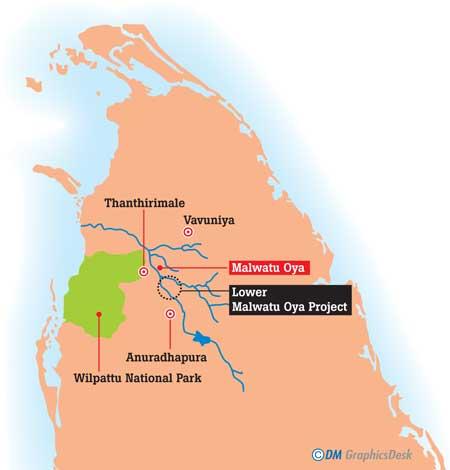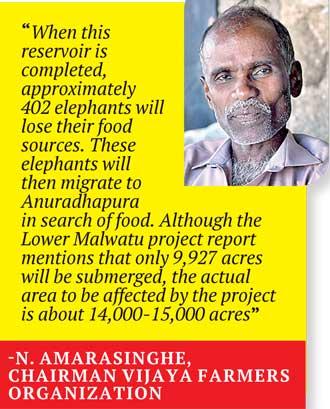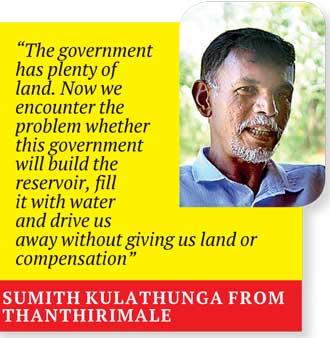Reply To:
Name - Reply Comment

The sluice gate of the reservior being made
 Currently, the world is not just discussing about development, but they are talking about sustainable development. Sustainable development should focus on conserving a country’s resources for the future. This approach is widely accepted at present. However, beyond this approach, many development projects continue to be implemented in this country. One such project is the construction initiative taking place across the Lower Malwatu Oya. Critics affirm that it is doubtful whether the intended objectives of the Lower Malwatu Oya project will be fulfilled, as it involves submerging resources under a reservoir that could be used for the country’s development. The project is currently underway, causing destruction to the natural ecosystem, a thriving agricultural colony, an archaeological and tourist area, as well as a habitat for wildlife.
Currently, the world is not just discussing about development, but they are talking about sustainable development. Sustainable development should focus on conserving a country’s resources for the future. This approach is widely accepted at present. However, beyond this approach, many development projects continue to be implemented in this country. One such project is the construction initiative taking place across the Lower Malwatu Oya. Critics affirm that it is doubtful whether the intended objectives of the Lower Malwatu Oya project will be fulfilled, as it involves submerging resources under a reservoir that could be used for the country’s development. The project is currently underway, causing destruction to the natural ecosystem, a thriving agricultural colony, an archaeological and tourist area, as well as a habitat for wildlife.
 When a country faces economic bankruptcy, the task of a responsible government is to rescue it from this state and guide it towards economic development. However, instead of prioritising economic growth and improving people’s lives, the Government of Sri Lanka (GoSL) has focused on spending on the Lower Malwatu Oya Reservoir Project, spending 35,000 million rupees on it while asking the populace to tighten their belts. It remains doubtful whether the fundamental objectives of this project, financed by the GoSL, will be achieved.
When a country faces economic bankruptcy, the task of a responsible government is to rescue it from this state and guide it towards economic development. However, instead of prioritising economic growth and improving people’s lives, the Government of Sri Lanka (GoSL) has focused on spending on the Lower Malwatu Oya Reservoir Project, spending 35,000 million rupees on it while asking the populace to tighten their belts. It remains doubtful whether the fundamental objectives of this project, financed by the GoSL, will be achieved.
So far, the government has aimed to accelerate the construction of the Lower Malwatu Oya Reservoir using the consolidated fund. In achieving this goal, the GoSL has already allocated funds and implemented the Lower Malwatu Oya Reservoir Project.
According to the Irrigation Department, there are many benefits to the Malwatu Oya project. The project was first established in 1960 under the Mahaweli Scheme. Agreements were reached with The Russian Government and an assessment study was conducted. However, the project didn’t commence due to political differences.
According to the project proposal for the Lower Malwatu Oya project, 17,000 acres of forests and residual forest lands in the Kappachi area will need to be submerged to create the reservoir. Additionally, another aspect of the project involves allocating 2,000 acres from the protected zone of Wilpattu National Park for fruit cultivation by individuals or organizations. Plans also include acquiring 675 acres of residual forest west of the Thanthirimale and Chendikulam road in Wilpattu National Park to resettle displaced people. In total, 19,675 hectares of forests and residual forests are slated for acquisition, in addition to the forests felled for the construction of canals, highways, work sites and offices related to the project. Furthermore, it has been decided to provide water to an additional 2,000 hectares of cultivated land that currently lacks access to water from Yoda Wewa, with the intention of cultivating economic crops. This decision was underscored by Wekandawala Rahula Thera and Environmentalist Dr. Ravindra Wijesinghe, based on recent data.
Despite authorities claiming benefits from this project, doubts remain about its actual advantages. These doubts arise because the government is constructing reservoirs using taxes collected from the people who are currently struggling to meet basic needs. Approximately 15,000 acres of land are being submerged for this reservoir, with plans to only utilise about  2,000 acres for cultivation. The land for the reservoir has been acquired from lands that were allocated to farmers who settled in the area during the Freedom from Hunger campaign in 1982-83. Residents of Thanthirimale pointed out that this project is a failure and that the government is prepared to harm the farmers who contribute significantly to the national economy.
2,000 acres for cultivation. The land for the reservoir has been acquired from lands that were allocated to farmers who settled in the area during the Freedom from Hunger campaign in 1982-83. Residents of Thanthirimale pointed out that this project is a failure and that the government is prepared to harm the farmers who contribute significantly to the national economy.
Imminent water shortage
During the construction of this reservoir, wildlife in Wilpattu National Park and the surrounding forests will face a significant water shortage. The water collected in the Lower Malwatu Oya reservoir will be used for commercial crop cultivation. Additionally, the area where this project is being built is a habitat for elephants and other animals. Despite Wilpattu being designated as a reserve, elephants and other animals are unaware of these boundaries; hence they do not confine themselves within it. One of the elephant corridors in the Anuradhapura region passes through the area where forests have been cleared and are now prepared for construction. Environmentalist Dr. Ravindra Kariyawasam pointed out that creating a reservoir in an area inhabited by elephants and resettling people in the forests beyond the buffer zone of Wilpattu National Park will inevitably lead to human-elephant conflicts.
N. Amarasinghe, Chairman of the Vijaya Farmers Organization, commented on this matter. He said, “As farmers, we have extensively communicated our concerns about this project to the authorities, but they haven’t considered our opinions. We formed organizations, but to no avail. We have given up on everything and are resigned to whatever will happen.
“Around 30 percent of Thanthirimale’s cultivated land was farmed this season. Elephants frequently come and destroy our crops. When this reservoir is completed, approximately 402 elephants will lose their food sources. These elephants will then migrate to Anuradhapura in search of food.
Although the Lower Malwatu project report mentions that only 9,927 acres will be submerged, the actual area to be affected by the project is about 14,000-15,000 acres. Initially, when the foundation stone was laid in 2014, the authorities stated that 360 families would be displaced due to the loss of lands. This number has now decreased to 242 families, and the reasons for  this reduction remain unclear. Villages are being built under the same names as our villages. They promised drinking water and water for farming, including three acres for cultivation. Now, none of those promises seems like being fulfilled. The people are being misled with false information regarding this project.
this reduction remain unclear. Villages are being built under the same names as our villages. They promised drinking water and water for farming, including three acres for cultivation. Now, none of those promises seems like being fulfilled. The people are being misled with false information regarding this project.
“It is reported that about 3,000 acres of paddy fields will be submerged due to the Malwatu Oya project. However, the actual area affected is even larger. It is said that nearly 1,200 households along with their paddy fields and homes will be affected. These lands are licensed lands granted by the government. My land that is to be submerged spans three acres, but despite applying for licences for all three acres, I was granted a licence for only half an acre. This is the treatment we receive. The lands of nine Grama Niladhari domains belonging to divisional secretariats such as Mahawilachchiya, Nuwaragam Palatha Central, Medavachchiya, and Settikulam are affected by the Lower Malwatu Oya Reservoir. According to the officials, wildlife and forest conservation, archaeological and environmental reports for this project haven’t been submitted yet. “In this area, there are prehistoric monuments dating back to 40,000-50,000 years. Such items possessing significant archaeological value.
These sites will be submerged. However, officials in charge of the project have stated that they would rescue and reconstruct salvageable archaeological monuments. Former Senior Surveyor Ajith Munasinghe highlighted the irony of attempting to protect unsalvageable artifacts by covering them with thick plastic to prevent destruction while submerged underwater,” said Amarasinghe.
Despite the commencement of the construction of the reservoir, there has been no mention of a compensation system for the displaced residents. Although it was said that land would be allocated to displaced people, the distribution of such land hasn’t begun yet. These lands, where people settled and farmed for 40-50 years before abandoning them, were designated as wildlife areas after the war concluded. Recently, these lands have been transferred to the government, with plans to allocate 500 acres to local residents, amounting to half an acre per family. Ajith Munasinghe said that following objections from residents, authorities promised to increase the allocation from half an acre to three-quarters of an acre per family.
 “The three acres of land allocated are designated for both cultivation and residential purposes. Residents who previously cultivated between 3 to 5 acres and earned income from their land with much effort have not yet received an assessment of their property’s value. Transitioning to a new life on these lands, even if it happens with the blessings of the government, is proving impractical,” Munasinghe said. According to Munasinghe the issue now is that those unable to sustain themselves on three acres may struggle to manage even half an acre.
“The three acres of land allocated are designated for both cultivation and residential purposes. Residents who previously cultivated between 3 to 5 acres and earned income from their land with much effort have not yet received an assessment of their property’s value. Transitioning to a new life on these lands, even if it happens with the blessings of the government, is proving impractical,” Munasinghe said. According to Munasinghe the issue now is that those unable to sustain themselves on three acres may struggle to manage even half an acre.
According to government officials, 242 families will be displaced by the Lower Malwatu Oya project. If three acres are given to each family, 672 acres will be needed; resulting in an increase of 172 acres. Sumith Kulathunga from Thanthirimale points out that it is problematic why the government retains enough land to allocate such amounts, but only gives half or three-fourths of an acre per family. “The government has plenty of land. Now we encounter the problem whether this government will build the reservoir, fill it with water and drive us away without giving us land or compensation,” Kulathunga added.
Kulathunga also said that the Wilachchiya Divisional Secretary has requested not to cultivate on the lands submerged by the reservoir in the Wilachchiya area. The Divisional Secretary has informed that occupants of lands- given without permission- cannot obtain water from the reservoir, so the required water for cultivation is provided by the lift irrigation method. However, Kulathunga added that water required for cultivation is not provided through the lift irrigation, and it is done only through the Water Supply and Drainage Board; which is tap water. It is not possible to engage in cultivation using that water. Kulathunga said that farmers will have to pay high water bills if they attempt cultivation using tap water.
In the lift irrigation system, water and land are allocated for cultivating inter-crops rather than paddy fields. Therefore, Amarasinghe said that the people will not receive any of the promised benefits from the Lower Malwatu Oya project. “The land allocated isn’t enough to build a house. This area amounts to half an acre of land on which crops grow. We have livestock, including chickens, goats and cows and these animals need space. The construction of the Lower Malwatu Oya Reservoir will not benefit the farmers; it will only waste the country’s money. It would be more beneficial for the farmers if the canals that carry water to Mannar were concreted, using just a quarter of the funds allocated for building the reservoir. Currently, about 30,000 acres are being cultivated in Mannar with this water. Only 2,000 acres can be cultivated with the new system, while about 15,000 acres will be submerged. This is a failed project. Government officials only tell farmers fairytales,” he added.
The Daily Mirror also made inquiries from Prasanna Thilakarathna, Project Director of the Lower Malwatu Oya regarding this issue. He said the following: “One of the objectives of  constructing the Lower Malwatu Oya Reservoir is to deal with flood control. Currently, Mannar farmers cultivate about 30,000 acres of paddy during the Yala season, but there is insufficient water for cultivation. Paddy fields are presently cultivated only during the Maha season. After the reservoir’s construction, the plan is to collect and distribute water for the cultivation during the Yala season. As a result of this reservoir, an additional 2,000 acres will be available for cultivation and this land is located near the reservoir.
constructing the Lower Malwatu Oya Reservoir is to deal with flood control. Currently, Mannar farmers cultivate about 30,000 acres of paddy during the Yala season, but there is insufficient water for cultivation. Paddy fields are presently cultivated only during the Maha season. After the reservoir’s construction, the plan is to collect and distribute water for the cultivation during the Yala season. As a result of this reservoir, an additional 2,000 acres will be available for cultivation and this land is located near the reservoir.
“The purpose of this reservoir is to collect and release water to Malwatu Oya and there is no other development processes. When constructed, it would displace 244 families along with their houses. There are 3,484 paddy land lots, with the first survey already completed. The Ministry of Lands will conduct the second survey. Approximately 10,000 acres will be submerged in the reservoir. They are forest lands and not lands inhabited; affecting four divisional secretariats. Among these lands are government land, paddy land, Chena lands and lands with houses and 244 families, including sub-families which are currently being identified.
“The GoSL bears the entire cost of constructing this reservoir; initially estimated at 23,000 million rupees as of 2021. Due to fluctuations in the US Dollar value, the updated estimate now stands at approximately 35,000 million rupees.
“The initial cost for constructing the reservoir dam and sluice was around 6000 million rupees, but recent calculations indicate it will amount to 13,000 million rupees. An additional 5,000 million rupees is allocated to build the canal system; based on contractor prices. However, if managed directly by the Ministry, the project yields a 10 percent dividends. Additional expenses of 16 million rupees have also been incurred, and that too can be saved to a large extent. Consequently, around 20 percent savings can be achieved from the project. “Compensation will be given for lands and houses submerged in the reservoir, although the exact amount hasn’t yet been finalised. An estimated 2,500 million rupees is allocated for compensation purposes and this amount is assessed by the Government Valuation Department. An Environmental Impact Assessment (EIA) has been conducted for this project, confirming that it will not harm wildlife. The report has been verified by wildlife authorities. Elephant corridors in Thanthirimale remain unblocked, but the corridor in Medavachchiya must navigate around the reservoir, and not across the reservoir. The environmental study report was conducted by a private company, and the corridor through Madu Church will not be blocked.
“Individuals losing paddy land will receive compensation in the form of alternative paddy land, with 2,000 acres already identified for this purpose. The land is surveyed and its area has been determined. Main families and sub-families will each receive land for the purpose of settlement. Main families will receive three-fourth of an acre each for residence, while sub-families will receive half an acre each. Those who lose both residential land and paddy land will be compensated with land for cultivation and paddy fields. Not all 3-4 acres will be provided simply because that amount was submerged; a systematic approach will be developed and land will be allocated accordingly, pending land assessments. Compensation is being offered to those unable to receive land, and only an additional 2,000 acres of land is available, with the remainder designated as a reserve.
“Plans include providing lift irrigation water facilities and piped water for the lands planned to be allocated. The reservoir’s total water volume is approximately 209 million cubic metres, capable of irrigating about 160,000 acre-feet and drinking water will also be provided. Anuradhapura, Vavuniya and Mannar will receive 22 cubic metres of water per year. Lift irrigation and pipeline facilities will be given for 2,000 acres. About 5 percent of the project has been completed thus far,” added Thilakarathna.
When asked about this issue, Maha Vilachchiya Divisional Secretary Manjari C. Chandradasa said, “The acquired lands are under cultivation, but compensation will not be paid. Currently, the process of granting land rights is underway. Work has temporarily halted due to the Urumaya program. New lands have been allocated, and the village has been reorganised post-resettlement. Infrastructure development is ongoing, with land release contingent upon meeting these requirements—half an acre is allocated for main families and ¾ acre for sub-families. ¾ acre is not allocated to a single individual. Road paving for the lands and electricity supply are pending. Progress has been slightly delayed due to the Urumaya programme,” said Chandradasa.